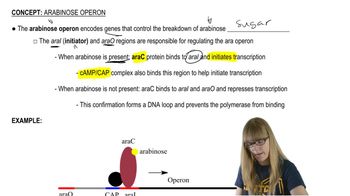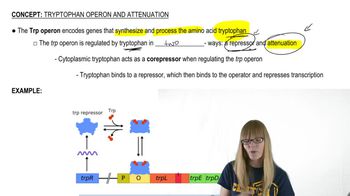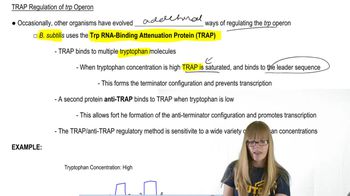Table of contents
- 1. Introduction to Genetics51m
- 2. Mendel's Laws of Inheritance3h 37m
- 3. Extensions to Mendelian Inheritance2h 41m
- 4. Genetic Mapping and Linkage2h 28m
- 5. Genetics of Bacteria and Viruses1h 21m
- 6. Chromosomal Variation1h 48m
- 7. DNA and Chromosome Structure56m
- 8. DNA Replication1h 10m
- 9. Mitosis and Meiosis1h 34m
- 10. Transcription1h 0m
- 11. Translation58m
- 12. Gene Regulation in Prokaryotes1h 19m
- 13. Gene Regulation in Eukaryotes44m
- 14. Genetic Control of Development44m
- 15. Genomes and Genomics1h 50m
- 16. Transposable Elements47m
- 17. Mutation, Repair, and Recombination1h 6m
- 18. Molecular Genetic Tools19m
- 19. Cancer Genetics29m
- 20. Quantitative Genetics1h 26m
- 21. Population Genetics50m
- 22. Evolutionary Genetics29m
12. Gene Regulation in Prokaryotes
Tryptophan Operon and Attenuation
Problem 11
Textbook Question
Explain the circumstances under which attenuation of operon gene expression is advantageous to a bacterial organism. Would you expect attenuation to be found in a single-celled eukaryote? In a multicelled eukaryote?
 Verified step by step guidance
Verified step by step guidance1
Understand the concept of attenuation: Attenuation is a regulatory mechanism used by bacteria to control gene expression, particularly in operons involved in amino acid biosynthesis, such as the trp operon in E. coli.
Identify the circumstances for attenuation: Attenuation is advantageous when a bacterial organism needs to quickly respond to changes in the availability of amino acids. It allows the organism to fine-tune gene expression based on the immediate needs for amino acid synthesis.
Consider the mechanism: In bacteria, attenuation involves the formation of a transcriptional terminator structure in the mRNA, which halts transcription when the end product (e.g., tryptophan) is abundant.
Evaluate the presence in single-celled eukaryotes: Attenuation is not typically found in single-celled eukaryotes because they have more complex regulatory mechanisms, such as alternative splicing and RNA interference, to control gene expression.
Assess the presence in multicelled eukaryotes: In multicelled eukaryotes, attenuation is unlikely to be a common mechanism due to the presence of even more sophisticated regulatory systems, including epigenetic modifications and extensive post-transcriptional regulation.
Recommended similar problem, with video answer:
 Verified Solution
Verified SolutionThis video solution was recommended by our tutors as helpful for the problem above
Video duration:
2mPlay a video:
Was this helpful?
Key Concepts
Here are the essential concepts you must grasp in order to answer the question correctly.
Attenuation in Gene Regulation
Attenuation is a regulatory mechanism in prokaryotes, particularly in bacteria, that allows for the premature termination of transcription based on the availability of specific metabolites. This process enables bacteria to quickly adjust gene expression in response to environmental changes, optimizing resource use and energy efficiency.
Recommended video:
Guided course

Trp Attenuation
Operons
An operon is a cluster of genes under the control of a single promoter, allowing for coordinated expression of genes that often encode proteins with related functions. In bacteria, operons facilitate efficient regulation of metabolic pathways, enabling rapid responses to changes in nutrient availability or environmental conditions.
Recommended video:
Guided course

Arabinose Operon
Differences in Gene Regulation between Prokaryotes and Eukaryotes
Prokaryotes, such as bacteria, often utilize simpler and more direct mechanisms like attenuation for gene regulation, while eukaryotes have more complex regulatory systems involving multiple layers, including chromatin structure and RNA processing. Consequently, attenuation is generally not found in single-celled or multicellular eukaryotes, as their gene expression regulation is more intricate and does not rely on such mechanisms.
Recommended video:
Guided course

Review of Regulation





